|
|

This chapter describes how to configure16- and 32-channel WCM systems, as well as 8-channel and 128-channel TDM4E systems. This chapter includes the following sections:
 |
Note Each NEMI must be configured individually for a specific operating environment. |
 |
Note Either the serial port or the Ethernet port can be used to log into the NEMI and configure the system (unless you have already connected the NEMIs together with their Ethernet ports). In this case, the serial ports remain unused. |
 |
Caution We recommend that you configure one port at a time, so that in case of mistakes, the other port can be used to correct any settings. |
If the NEMI is powered on and has been connected correctly to the laptop, you should see the following Linux login greeting:
unknown login
For information about connecting to the NEMI, refer to the Cisco Metro 1500 Series Hardware Installation Guide.
Now you can log in as one of the following accounts: root, netadmin, or user.
 |
Note The default password for all of these accounts is ChgMeNOW. To guarantee secure operation, we recommend that you change the default passwords (for root, netadmin, and user) as soon as possible. |
You can change your account passwords using the passwd command. For example, to change the password for the netadmin account, enter:
passwd netadmin
To change the password for the user account, enter:
passwd user
 |
Note UNIX is case-sensitive. |
For administration, we recommend using the netadmin account. System setup, which is typically done once per system, requires root privileges. Root is the most powerful account and should be used for system setup only. Root can change the passwords of other accounts. The netadmin and user accounts can be used during normal system operation.
Once you have logged in, you can configure the system using the netconfig command to access the setup menus and screens. At the command prompt, enter:
netconfig
Depending on your terminal emulation (Telnet, HyperTerminal, or CRT), the screen output may be different from one connection type to the other. If your screen differs greatly from those shown in the following figures, press ESC to stop the netconfig command and change your terminal settings.
Make your screen windows as large as possible. Change the terminal emulation of the NEMI by typing TERM=vt100, TERM=linux, or TERM=ansi. The netconfig screens are best viewed with Microsoft's Telnet application using TERM=vt100. Figure 3-1 shows the netconfig menu screen.

After changing your terminal emulation settings, enter the netconfig command again:
netconfig
Use the cursor keys, +, -, Tab, or the highlighted initial characters to move about the system's menus and screens.
 |
Note For this guide, all screen displays were reversed because terminal screens typically show light characters on a dark background. |
To change configuration files and other text-based files, the NEMI has two text editors available: pico and vi. For ease of use, we recommend using the pico editor.
The pico text editor is a member of the pine mail-kit, which is not included. There is a very short learning curve with pico because the most frequently used commands are displayed in the bottom two lines of the screen. For more information about pico, see "Command Reference."
To avoid line wrapping in pico, always start pico with the -w option, as follows:
pico -w filename
In 16-channel WCM or 8-channel TDM4E systems, the primary chassis contains the NEMI module and extension chassis A contains the DEMI module. Both the NEMI and DEMI modules must be interconnected using an external bus cable. (Refer to the Cisco Metro 1500 Series Hardware Installation Guide.) In this configuration, only the NEMI is configured. Figure 3-2 shows the physical configuration of a 16-channel WCM system.
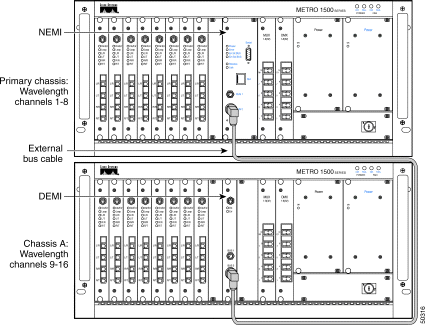
 |
Note The physical configuration of an 8-channel TDM4E system is the same as that of a 16-channel WCM system, except that it contains four TDM4E modules in each chassis rather than eight WCMs in each chassis. For this reason, the configuration steps for the 8-channel TDM4E system are the same as for the 16-channel WCM system. |
Figure 3-3 shows a flowchart of the steps necessary to configure 16-channel WCM or 8-channel TDM4E systems.

To configure 16-channel WCM or 8-channel TDM4E systems, follow these steps:
Step 1 Log into the NEMI. (See the "Logging into the NEMI" section.)
Step 2 Confirm at the NEMI setup screen that you have a 32-channel system. Enter No to indicate that you have a 16-channel WCM or an 8-channel TDM4E system. See Figure 3-4.

Step 3 Confirm at the NEMI 16-channel setup screen that you are logged in to a 16-channel WCM or an 8-channel TDM4E system. See Figure 3-5.
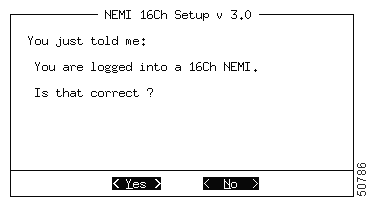
Step 4 Configure the NEMI. See the "Setting Configuration Options" section.
This section describes how to set the following NEMI configuration options:
Figure 3-6 shows the NEMI 16-channel setup menu, from which you set these configuration options. Use this menu for configuring 16-channel WCM systems as well as 8-channel TDM4E systems.

 |
Note You also use these options to configure 32-channel WCM and 128-channel TDM4E systems. For detailed information about configuring these systems, including how to configure the NEMI-master and NEMI-slaves, see the "Configuri ng 32-Channel WCM and 128-Channel TDM4E Systems" section on. |
To set the time zone for your system, follow these steps:
Step 1 Log into the NEMI as root and run the netconfig command. From the NEMI setup screen choose Zone to select your local time zone. See Figure 3-7.
Step 2 Move the cursor to find your time zone. Enter OK.

Step 3 Exit netconfig, but do not reboot.
The NEMI supports the Network Time Protocol (NTP). NTP synchronizes the time of a computer client or server to another server or reference time source. The time source can be a radio or satellite receiver or modem. NTP provides client accuracies typically within a millisecond on LANs and up to a few tenths of a millisecond on WANs relative to a primary server synchronized to Universal Time Coordinated (UTC).
Typical NTP configurations utilize redundant servers and diverse network paths to achieve high accuracy and reliability. Some configurations include cryptographic authentication to prevent accidental or malicious protocol attacks.
For more information about the NTP architecture, protocol, and algorithms, log onto the following web page:
http://www.eecis.udel.etu/~ntp/
 |
Note Using the NTP for time zone and time synchronization is optional. |
NTP has many options that depend on the time server setup. You need to be familiar with NTP, the Cisco Metro 1500 series system configuration, and the networking options to complete this setup.
To set up the NTP, follow these steps:
Step 1 Get the IP addresses of the installed time servers from the system administrator. For reliability, more than one time server should be active (three is optimal).
Step 2 Use the pico -w /etc/ntp.conf command to open and edit the ntpd configuration file. See Figure 3-8.

Step 3 Replace the x.x.x.x of the server lines with the IP addresses you got from the system administrator. Remove the comment character (#) for each line with a valid IP address.
Step 4 Exit and save the ntpd.conf configuration file by entering Ctrl-X and Y.
Step 5 Set the NEMI to approximately the right time. You can either use the ntpdate command or the netconfig command.
 |
Note We recommend that you use the ntpdate command because ntpdate gets the time information from a time server and can be used to check if the time server is available. |
Step 6 Terminate the ntpd daemon before using ntpdate. Enter ps ax to get the process ID of the ntpd. This command lists all of the active processes on the Linux system. In our example the ntpd process ID is 107. See Figure 3-9.
Terminate the ntpd daemon by entering:
kill process-ID
Use the ntpdate command to get the actual time from one time server, as follows:
ntpdate time-server
where time-server is one of the IP addresses that you got from the system administrator.

Step 7 Use the clock -w command to synchronize the NEMI's CMOS clock.
Step 8 Reboot the system.
After reboot, the ntpd daemon starts automatically and synchronizes the NEMI's clock with the time server.
Figure 3-10 shows an example of Step 7 through Step 7.

The NEMI sets the date and time using numbers only. To set the date and time, follow these steps:
Step 1 Log into the NEMI as root and run the netconfig command.
Step 2 Select Date.
Step 3 Enter 022709552001 to set the date and time to 27 Feb. 9:55 a.m. 2001. The format is MMDDhhmmCCYY, where MM is month, DD is day, hh is hour, mm is minute, CC is century, and YY is year. See Figure 3-11.

 |
Note You must reboot the NEMI before the new date settings take effect. |
To configure the NEMI for use on an IP network, ask your network administrator for the following information and fill in the Unit Maintenance and Network Record available in the Cisco Metro 1500 Series Hardware Installation Guide:
Once you have the necessary information (see "About IP Addresses"), log into the NEMI and use the netconfig command to enter your system's values. See Figure 3-12 through Figure 3-19 for the steps necessary to configure the NEMI's IP network.






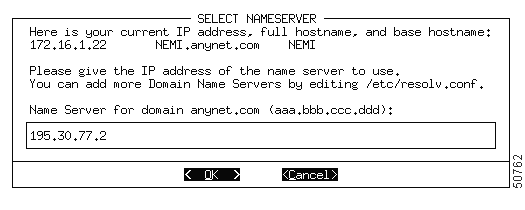
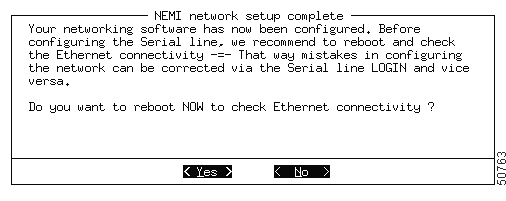
 |
Note Check your Ethernet settings carefully before doing any further configuration. |
Enter Yes to confirm your configuration settings and reboot the system.
After confirmation the new network settings take effect.
After this reboot, if the correct IP addresses and masks have been defined, the NEMI shows up on the network. To test the success of the NEMI network configuration, try to ping the NEMI from another computer that is connected to the same network as the NEMI.
For example, from a Windows 95/98 system, open a DOS window and enter the ping xx.xx.xx.xx command, where xx.xx.xx.xx is the host IP address you entered when configuring the NEMI's IP network. If you receive a reply, the connections have been configured correctly. See Figure 3-20 for an example of the system's reply to the ping command. If you receive a time-out message, either the NEMI's Ethernet settings are not correct or there is a hardware problem. See Figure 3-21 for an example of the timed-out message.

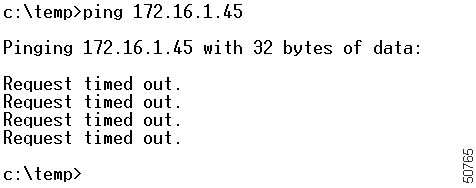
You can use the NEMI's serial port to make the following connections:
If you intend to use the serial line for network management, we recommend using PPP.
 |
Note You can set the speed of the serial line to 9600, 19200 or 38400 Kbps. Only use the 38400 Kbps setting if you are sure that your computer has a 16550 UART interface circuit. |
See Figure 3-22 through Figure 3-26 for the steps necessary to configure the serial connection. Select ConSerial from the netconfig menu screen to access these options.

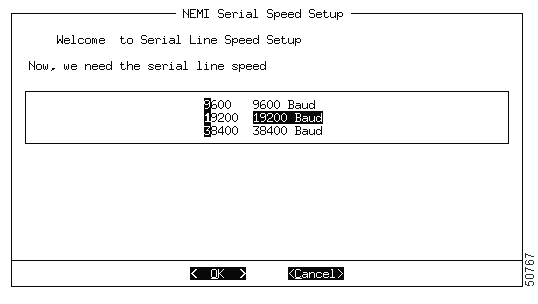


If you dial in with a modem or leased line, we recommend using PPP. PPP establishes a network connection similar to an Ethernet connection. You must enter the IP addresses for both sides of the PPP connection and the netmask. See Figure 3-26.

The Cisco Metro 1500 series system supports the following external modems:
All of these modems are shipped with serial and phone-line cables. Modems must be connected with a line speed of 38.4 kbps and are automatically set up to support PPP.
The remote system can either be a terminal concentrator or a network management system, and they are connected to the other side of the PPP connection. Because PPP has only two stations on the network, the netmask can be automatically set by the computer. However, you can save address space by setting the subnet mask manually. See Figure 3-27.

For a typical configuration, the Ethernet IP address on the NEMIs should be different from the PPP IP address. However, it is possible to choose the same addresses for both interfaces. See Figure 3-28 and Figure 3-29.

The NEMI can direct Simple Network Management Protocol (SNMP) traps to a specific system if it is installed on a permanent network. To access SNMP options, select TrapIP from the NEMI setup menu. See Figure 3-30.

You can also use the snmpconfig command to configure more than one system to receive traps or multiple systems to receive classes of traps. See "Command Reference."
You can save your NEMI settings in the NEMISAVE.TGZ file. This file can be copied to other NEMIs and then restored there. This simplifies setting up multiple systems or making a backup of current settings.
To save your current settings, select Save from the NEMI Setup menu.
The Continue? screen asks you to confirm that you want to save your current settings. See Figure 3-31.

Enter Yes to save your current NEMI settings.
To access the information screen and display current NEMI settings, select Info from the netconfig main menu. The information screen (Figure 3-32) shows the following settings:
This screen shows the changes you have made. However, these changes are only activated after a system reboot. The header line shows the netconfig version in use. Make sure that you have the latest available version.
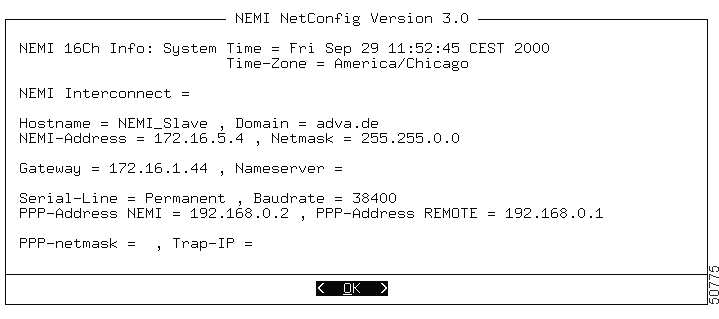
 |
Caution Be careful when using any of these restore options. Failure to do so may result in an unusable system. |
The NEMI setup menu provides the following options for restoring the system to previously saved configurations:
For systems using more than 16 channels (for example, 17 single-width WCMs or 9 double-width TDM4E modules or more) additional chassis are required.
The first two chassis contain a NEMI and a DEMI. In the extension chassis, the NEMIs and DEMIs must be installed alternately. Each DEMI is connected by an external bus to its NEMI and all NEMIs are connected to the Ethernet hub.
The first NEMI in the primary chassis is configured to be the NEMI-master and all subsequent NEMIs are configured to be NEMI-slaves. When configured this way, the whole system can be addressed through the Ethernet hub, using one IP address. This interconnection is the inter-NEMI network connection or INNC.
This section describes how to configure both the NEMI-master and the NEMI-slaves for 32-channel WCM and 128-channel TDM4E systems.
Figure 3-33 shows the physical configuration of a 32-channel WCM or a 128-channel TMD4E system.

Figure 3-34 shows a flowchart of the steps necessary to configure 32-channel WCM or 128-channel TDM4E systems.

When you log into the NEMI you are asked if you are setting up a 32-channel system. If you answer No, you are directed to configuration procedures for a 16-channel system. If you answer Yes, you are directed to configure the NEMI-master and NEMI-slaves for the INNC. After configuring the NEMI-master and NEMI-slaves, you can return to the "Setting Configuration Options" section to set general options for the NEMI.
The following configuration steps must be repeated for the NEMI-master and NEMI-slaves:
1. Run the /etc.ResetNemiConfiguration command.
2. Use netconfig to complete the configuration.
The INNC needs an 8-address block of IP addresses from a network address range that is not used locally and is not routed.
 |
Note The NEMI-master uses the default address +1 of this block, whereas the NEMI-slave uses the default address +2. The first and last addresses are reserved. |
 |
Note Make note of the IP address of the 8-address block you use, as it will be needed for configuring the NEMI-slaves. |
To configure a NEMI-master on 32-channel WCM or 128-channel TDM4E systems, follow these steps:
Step 1 Log in as root and enter:
/etc/.R <Tab><Enter>
Pressing Tab and Enter after the R invokes filename recognition. Because there is only one filename that starts with .R in the /etc directory, you see the following:
/etc/.ResetNemiConfig
Press Enter to start this program.
The ResetNEMIConfig file resets the default 16-channel configuration and allows you to define a new 32-channel configuration. The NEMI reboots.
Step 2 Log in again as root after the reboot, and enter the following:
netconfig
You see the NEMI setup screen. See Figure 3-35.

Step 3 Select Yes to begin a 32-channel WCM or 128-channel TDM4E configuration.
 |
Note If you select No, you are directed to the NEMI setup procedures for 16-channel WCM or 8-channel TDM4E systems. See the "C onfiguring 16-Channel WCM and 8-Channel TDM4E Systems" section. |
The next NEMI setup screen asks if you are connected to a NEMI-master. See Figure 3-36.
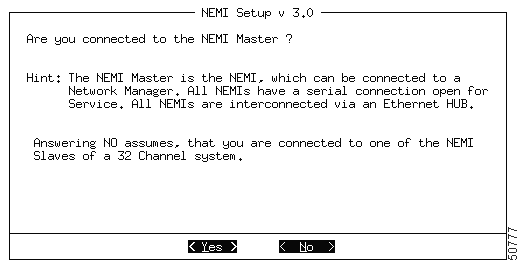
Step 4 Enter Yes to access the NEMI 32-channel master setup screen. See Figure 3-37.
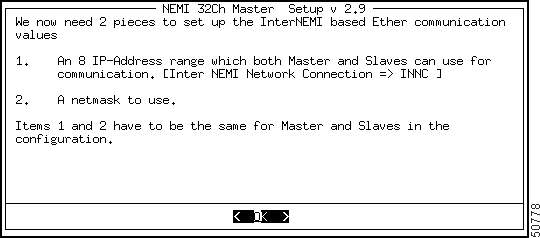
Step 5 Press Enter to access the Enter NEMI 32-Channel Master Start of IP Address Range screen. See Figure 3-38.

The NEMI-master is automatically assigned its correct position in this block. When repeating this step for the NEMI-slaves, each is assigned its correct position in the address sequence according to the information you have entered. After confirming the IP address, you must enter the NEMI netmask. See Figure 3-39.
 |
Note Make note of the NEMI netmask, as you will need it when you configure the NEMI-slaves. |

Step 6 Confirm your NEMI setup after entering and confirming the netmask. Confirm your configuration options, by selecting Yes. See Figure 3-40.

The NEMI 32-channel master setup screen confirms that you have finished entering the basic values required to set up the INNC. See Figure 3-41.

After setting up the INNC for the NEMI-master and the NEMI-slaves, all NEMIs have the same view of the system. The NEMI-master might require some other general settings. See the "Setting Configuration Options" section. The Ethernet IP address must be set to be visible to the network management system. The date, time zone, and SNMP trap IP address must also be set. You can configure these settings from the NEMI 32-channel master setup screen. See Figure 3-42.
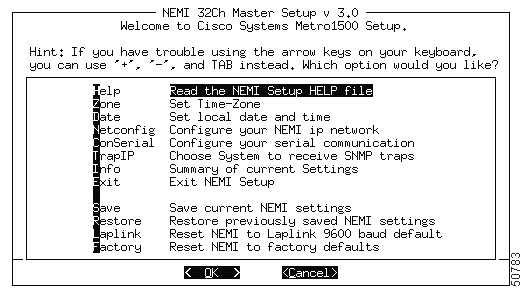
NEMI-slaves are configured after you have configured the NEMI-master.
 |
Note Before you begin, you need the IP address of the 8-address block and the netmask used to configure the NEMI-master. |
Configure the NEMI-slaves just as you did when you configured the NEMI-master. See the "Configuring a NEMI-Master" section.
The NEMI setup identification screen asks if you are connected to a NEMI-master. See Figure 3-36.
To configure the NEMI-slaves, follow these steps:
Step 1 Enter No when the NEMI setup identification screen asks if you are connected to the NEMI-master. You see the Enter Metro 1500 NEMI 32-Channel Slave Number screen. See Figure 3-43.

Step 2 Enter the NEMI-slave number. See Figure 3-33 for the physical configuration of the chassis and placement of the NEMI-master and NEMI-slaves. We recommend that you designate the NEMIs as follows:
| NEMI | Position |
|---|---|
NEMI-master | Primary chassis in rack 1 |
NEMI-slave 1 | Extension chassis B |
NEMI-slave 2 | Extension chassis D |
NEMI-slave 3 | Extension chassis F |
Step 3 Continue to configure the NEMI-slaves as you did the NEMI-master from the NEMI 32-Channel Slave Setup screen. See Figure 3-44. The configuration program assigns the correct IP address within the IP-address block to the NEMI-slaves.

Step 4 Select Exit from the NEMI 32-Channel Slave Setup screen after configuring and confirming the setup for each NEMI-slave.
Use one of the following procedures to reboot the NEMI:
 |
Caution This procedure results in a complete loss of all electrical and optical functions for the duration of the power cycling. |
Security within the Linux operating system is robust. Because the Cisco Metro 1500 series system can supply a sizable portion of network bandwidth to the enterprise, security is a major concern. However, situations do arise when one of the access passwords to the system is not readily available, but access needs to be provided as soon as possible.
For these reasons, the system offers a password reset option that returns all passwords to their factory defaults.
To reset the factory passwords, follow these steps:
Step 1 Connect a computer to the chosen access port (either Ethernet or serial) and use a small diameter tool (such as a mechanical pencil or a straightened paper clip) to reset the NEMI.
Step 2 Count the beeps of the NEMI during reboot (one from the BIOS and two pairs at the start of a 20-second time window) for a total of five beeps.
Step 3 After the fifth beep, log in to the system using the following account and password:
account: Maint
password: ChgMeNOW
 |
Note UNIX is case-sensitive. Successfully logging into the Maint account results in a pair of triple beeps and a reboot. Once rebooted, the system passwords are reset to their factory default values. |
All logins are logged by the system. Restarts are also logged and transmitted using SNMP. The Maint account is only open for 20 seconds after the last beep. Any attempt before or after that time leads to standard UNIX procedures for handling wrong passwords or illegal logins (next login is delayed).
Therefore, you must wait until the last beep to avoid system delays. It might take several attempts to complete this procedure. Only passwords are reset to factory defaults. All other settings and performance of the optical transmission systems are unaffected. This procedure does not interrupt optical traffic.
We recommend that you personalize the NEMI passwords as soon as possible to minimize possible exposure. This is true even if the endpoints of the optical network are within the physical security zone. You should restrict access to the NEMI to keep system security (and system stability) high.
![]()
![]()
![]()
![]()
![]()
![]()
![]()
![]()
Posted: Sat Sep 28 02:49:01 PDT 2002
All contents are Copyright © 1992--2002 Cisco Systems, Inc. All rights reserved.
Important Notices and Privacy Statement.